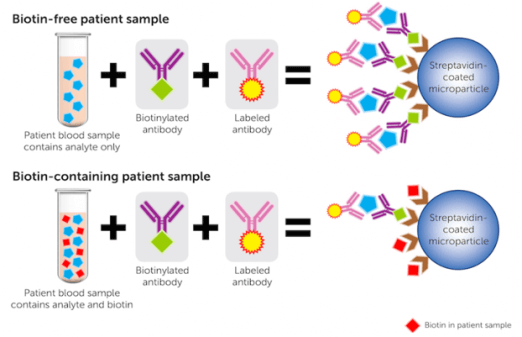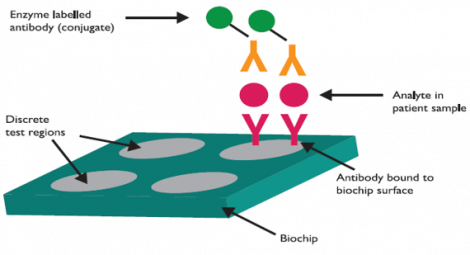Randox Biochip Array (BAT) Technology free from Biotin-Streptavidin
Randox Biochip Array (BAT) Technology free from Biotin-Streptavidin
![Biotin - landing page banner[2] Biotin](https://www.randox.com/wp-content/uploads/2018/07/xBiotin-landing-page-banner2.jpg.pagespeed.ic.33PpDA8fvo.jpg)
Biotin, also known as vitamin B7, is involved with fatty acid metabolism, amino acid degradation, and gluconeogenesis. The recommended daily intake for biotin is roughly 30-70µg, which is extremely low, meaning that biotin deficiency is rare. Recently, there has been a surge in biotin supplementation mainly for beauty reasons, including: stronger nails and healthier skin and hair, resulting in the biotin craze on Instagram. Currently 162K posts are attributed to the biotin hashtag (#biotin) on Instagram. Whilst biotin supplementation is beneficial for numerous health conditions, including: multiple sclerosis (MS), diabetes, elevated cholesterol, and metabolic dysfunction, the increasing use of biotin by patients has created a problem with in vitro diagnostic testing.
With numerous manufacturers using biotin-streptavidin technology to develop in vitro diagnostic tests, combined with the rise in biotin supplementation use, the FDA (food and drug administration) issued an alert regarding the potential for erroneous results triggered by high levels of biotin in patient samples, at the end of 2017. Clinical decisions based on these false results from biotin technology can lead to inaccurate diagnosis and inappropriate treatment prescribed. The FDA confirmed that a patient, who was consuming high levels of biotin, died when a troponin tested was skewed and failed to show that the patient was having a heart attack. Other tests that can produce erroneous results include: cardiac, pregnancy, cancer and iron-deficiency tests.

(Halasey, 2018)
The image above highlights that in biotin-free patient samples, the analyte to be tested successfully binds to the biotinylated antibody and the labelled antibody ultimately ensuring accurate measurement. In the patient sample containing high levels of biotin, the biotin inhibits streptavidin’s ability to capture the analyte-antibody complex, generating falsely lowered results.
As 70% of all clinical decisions are based on results from in vitro diagnostic tests, it is vital that laboratories are selecting in vitro diagnostic tests that do not adopt the biotin-streptavidin technology to ensure accurate patient testing.
Randox do not utilise the biotin-streptavidin technology in the development of the Biochip Array Technology (BAT).

The Randox Biochip facilitates multiplex testing for faster, more comprehensive patient testing. This technology, free from biotin-streptavidin, uses capture antibodies bound to a solid substrate (biochip surface) as opposed to biotinylated antibodies used by other manufacturers. The Biochip also utilises enzyme labelled conjugate to enable chemiluminescent detection of the target in the patient sample.
Biochip test menu

The Biochip Array Technology (BAT) from Randox is capable of simultaneous multi-analyte diagnostic testing within the fields of clinical research and drugs of abuse testing. The technology works through combining a panel of related assays on a single biochip with a single set of reagents, controls and calibrators. An extensive range of Biochip panels are available, each optimised to provide the best performance.
Evidence

The evidence analyser is the world’s first protein Biochip Array Technology system and has truly transformed laboratory diagnostics worldwide. As the first of its kind, the Evidence has introduced higher standards of quality efficiency and reliability to numerous sectors including hospitals and clinical laboratories, forensic and clinical toxicology, pharmaceutical/CRO applications, as well as veterinary laboratories.
Evidence Evolution

The world’s first fully automated random access Biochip testing platform. The Evidence Evolution is set to revolutionise current diagnostic testing. With the capability to process up to 2,640 tests per hour, the Evidence Evolution utilises multiplexing technology, offering advanced test consolidation, patient profiling, a complete system integration, as well as the most comprehensive test menu on the market.
Investigator

The #1 choice for research, clinical, forensic, and veterinary testing. Using the multiplexing technology, the semi-automated benchtop immunoanalyser Evidence Investigator is suitable for medium throughput laboratories. In addition to the current test menu for this analyser, Randox have new tests in development.
Reference:
Halasey. S, 2018, “Inside Track: Biotin Gets a Safety Alert”. Available from URL: http://www.clpmag.com/2018/01/inside-track-biotin-gets-safety-alert/
The Evidence Series: What is it and how is it changing the diagnostic landscape forever?
Having developed the patented Biochip Array Technology following £250 million investment in diagnostic research and development, we needed a platform that allowed Biochip Array Technology capabilities to be showcased. Step forward the Evidence Series.
The series includes the Evidence, the Evidence Evolution, the Evidence Investigator and the Evidence MultiSTAT. Each analyser has been designed and built with boundary pushing engineering, to ensure financial, labour and time savings for the end user.
Have a read below of the overview of each analyser in the Evidence Series
Evidence Evolution
The world’s first fully automated random-access biochip testing platform, the Evidence Evolution is the world’s most advanced immunoanalyser. With the capability to process up to 2,640 tests per hour, the Evidence Evolution offers complete system integration, as well as the most comprehensive test menu on the market.
Evidence
As the world’s first Biochip Array Technology system, the Evidence immunoanalyser has revolutionised laboratory screening worldwide. With the capability to process 3,960 tests per hour and a sample capacity of 360, the Evidence is ideal for use in a high throughput laboratory.
Evidence Investigator
The Evidence Investigator is a compact, semi-automated benchtop immunoanalyser that offers efficient and comprehensive testing across a range of applications including clinical diagnostics, molecular, toxicology and food diagnostics. The Evidence Investigator boasts a throughput of up to 2,376 tests per hour, offering efficiency without compromising on accuracy.
Evidence MultiSTAT
The Evidence MultiSTAT is a fully automated immunoanalyser that enables on-site simultaneous detection of up to 44 analytes from a single sample of oral fluid, urine or blood. With a three-step process and results generated in less than 20 minutes, the Evidence MultiSTAT is an ideal solution for those with no knowledge of laboratory procedures and offers a throughput of up to 132 tests per hour.
About the Randox Evidence Series
The Evidence Series is set to revolutionise diagnostic testing forever. Offering unrivalled capabilities across all analysers, we truly believe that the Evidence Series range of immunoassay analysers can meet your diagnostic testing capabilities.
For more information on any of the Evidence Series analysers, please visit https://www.randox.com/evidence-series/ or contact us evidenceseries@randox.com.
Powering the Evidence Series – Biochip Array Technology
In 2002, Randox invented a worlds first; Biochip Array Technology, instantly changing the landscape of diagnostic testing forever. Biochip Array Technology is a multi-analyte platform which provides an unrivalled increase in patient information per sample. Instead of a patient sample needing to be subdivided for each test result, or in some cases re-collected, Biochip Array Technology offers a diagnostic patient profile with each patient sample.
How does it work?
Biochip Array Technology is a precision multiplex testing platform allowing for the simultaneous quantitative or qualitative detection of a wide range of analytes from a single sample.
The biochip detection system is based on a chemiluminescent reaction. This is the emission of light, without heat, as a result of a chemical reaction. An enzyme is used to catalyse the chemical reaction on the biochip which generates the chemiluminescent signal. The light emitted from the chemiluminescent reaction that takes place in each DTR is simultaneously detected and quantified using a Charge-Coupled Device (CCD) Camera.
Each biochip has up to 49 Discrete Test Regions (DTR). This means that up to 44 tests can be carried out simultaneously. The additional DTR are reserved for internal quality control and visual reference, a unique Biochip Array Technology feature.
How is the technology applied?
With over £250 million invested into Biochip Array Technology research and development, Randox have launched a range of Biochip Array Technology immunoanalysers – The Evidence Series. This includes the Evidence, the Evidence Evolution, the Evidence Investigator and the Evidence MultiSTAT. Each analyser is developed with boundary pushing engineering, designed to make financial, labour and time savings for the end user.
The Evidence Series has truly revolutionised diagnostic testing forever. Offering unrivalled capabilities across all analysers, we truly believe that the Evidence Series range of immunoassay analysers can meet your diagnostic testing capabilities.
For more information on any of the Evidence Series, please visit http://www.randox.com/evidence-series/ or contact us evidenceseries@randox.com.
The Evidence Evolution: The world’s most advanced immunoassay analyser
What sets the Evidence Series apart from its competitors is its flexibility across the range of immunoassay analysers. No other range of analysers has the capability in terms of throughput in comparison to the Evidence Series. With this established, we are delighted to introduce the latest in the Evidence Series range, the Evidence Evolution.
Join the Evolution
We believe that the Evidence Evolution is the world’s most advanced immunoassay analyser. The Evidence Evolution is the most versatile analyser Randox has ever produced. By utilising the same multiplex technology as the other Evidence Series analysers, the Evidence Evolution can process up to 44 results from a single sample, with a maximum throughput of up to 2640 tests per hour. With such a high volume of potential throughput, you may think that reporting time will be compromised, that is simply not the case. The Evidence Evolution can produce the first set of results in less than 36 minutes, with one sample of up to 44 results reported every minute after. The speed of reporting time distinguishes the Evidence Evolution from its competitors, and allows the analyser to further display its capabilities.
Innovation
By utilising patented Biochip Array Technology, the Evidence Evolution offers batch analysis, true random access and STAT testing capabilities. These, combined with retrospective testing, allows the user to build a more in-depth patient profile.
With such swift reporting times, the Evidence Evolution can boast of a true walkaway time of 2 hours, in a laboratory setting, this can be vital. With multiple daily tasks to be completed, time is of the essence, and the Evidence Evolution has been designed to lessen the workload of laboratory staff. By being able to offer a combination of continuous sample and reagent loading, plus automated on-board sample dilution, the Evidence Evolution will have a positive impact in busy laboratories.
Complete Picture
A fast reporting time and high throughput capabilities is just the tip of what the Evidence Evolution can offer. The analyser has the capability to test across multiple matrices, allowing for more flexibility in sampling. It also comes equipped with state of the art intuitive software and advanced precision bio-drive robotics, meaning the Evidence Evolution is an analyser that has been designed and developed to meet the needs of a modern, high throughput laboratory, by a company that has a deep understanding of laboratory needs.
About the Randox Evidence Series
The Evidence Series is set to revolutionise diagnostic testing forever. Offering unrivalled capabilities across all analysers, we truly believe that the Evidence Series range of immunoassay analysers can meet your diagnostic testing capabilities.
For more information on the Evidence Evolution, or any of the Evidence Series analysers, please visit http://www.randox.com/evidence-series/ or contact us evidenceseries@randox.com.
Randox showcases future-proofing diagnostic technology at MEDICA 2017
Randox Laboratories, the world-leading medical diagnostics manufacturer, is showcasing advancements in laboratory technology at the 2017 MEDICA – World Conference for Medicine conference, being held November 13-16 in Dusseldorf, Germany.
Unveiling its state-of-the-art interactive exhibition stand, Randox will host a series of demonstrations of its innovative analysers including the Evidence Evolution and Rx modena, and a number of exciting advances in laboratory medicine, involving increasing the test menu available to clinicians and improving the connectivity of laboratories across the world to improve overall quality.
“Through our advancements in laboratory innovation, we’re driving an industry-wide evolution” said Randox CEO, Dr Peter FitzGerald.
“Our products are leading the way in innovation and enabling laboratories to transform the way they operate. We will be hosting demonstrations of a wide range of our fully-automated analysers, which are packed with cutting-edge technology and intuitive software. The goal is to provide future-proof diagnostic technology that will create the most efficient and effective laboratories.”
Paving the way is Randox’s patented Biochip Array Technology (BAT). This multi-analyte testing platform is the product of a £250 million research and development project. The ceramic tile measuring 9×9 mm can currently run up to 49 assays simultaneously,100 assays in the near future. This innovation allows the simultaneous quantitative or qualitative detection from a wide range of analytes from a single sample. It is suitable for use in a wide range of laboratories including clinical, research, hospital, veterinary and forensic and clinical toxicology.
To enhance the benefits of BAT, Randox introduced the Evidence Evolution to its stable of immunoassay analyser platforms. The Evidence Evolution is the world’s first fully automated random-access biochip testing platform, capable of delivering 2640 results in one hour, with the first delivered in just 37 minutes.
Joining the Evolution in Hall 3 stand A08 is the RX modena. This highly reliable, precise, fully automated clinical chemistry analyser can run 1200 tests per hour including ISE. When combined with its unrivalled RX series test menu, it offers a winning combination for all large, multi-disciplinary laboratories.
“We develop more new tests than any other diagnostics manufacturer, and one of the products that we’re showcasing at this year’s MEDICA is Adiponectin,” added Susan Hammond, Global Sales Manager at Randox.
“This novel biomarker is a powerful new weapon in the fight against some of the biggest health issues faced throughout the world including diabetes, cancers and cardiovascular disease. As it’s World Diabetes Day on Tuesday 14th November, it’s a great opportunity to draw attention to this array which labs can run as part of their routine testing panel.”
MEDICA attendees will also be among the first to experience the advancements delivered by the latest update for Randox’s Acusera 24.7. This online interlaboratory data management and peer reporting package is now smarter, faster and more powerful than ever before.
Acusera 24.7 is designed to help laboratories efficiently review QC data from all their lab instruments on one central platform, thereby allowing quick and easy identification of QC failures and emerging trends. Unique access to peer group data updated instantly in real-time from our global network of laboratory participants will speed up troubleshooting and help pinpoint the root cause of any QC failures by easily identifying if an issue is isolated or widespread.
The Randox team will be on hand throughout MEDICA 2017 at stand #3A08. To make an appointment in advance, contact them through the Randox MEDICA webpage.
Click here for more information on Randox, or to get in touch, phone the Randox PR Team on 028 9442 2413, or email randoxpr@randox.com
Evidence Series Immunoanalysers

Powered by Biochip Array Technology
In 2002, Randox invented a world first, Biochip Array Technology (BAT), instantly changing the landscape of diagnostic testing forever. BAT is a multi-analyte platform which provides an unrivaled increase in patient information per sample. Instead of a patient sample needing to be subdivided for each test result, or in some cases re-collected, Biochip Array Technology offers a diagnostic patient profile with each patient sample. So now the patient’s needs become the focus, as BAT delivers the multiple results needed for improved diagnosis.
With over £250 million invested into Biochip Array Technology research and development, Randox have launched a range of Biochip Array Technology immunoanalysers – The Evidence Series. This includes the Evidence, the Evidence Investigator and the Evidence MultiSTAT. Each analyser is developed with boundary pushing engineering, designed to make financial, labour and time savings for the end user. Utilising this technology, the Evidence series guarantees cost-effective, highly accurate and flexible testing solutions.
Why choose the Evidence Series?
Biochip Array Technology Test Menu
Adhesion Molecules
| E-Selectin | P-Selectin | L-Selectin | |
| Intercellular Adhesion Molecule-I – ICAM-I | Vascular Cell Adhesion Molecule-I –VCAM-I | ||
Alzheimer’s
| Apolipoprotein E4 –ApoE4 | Pan Apolipoprotein E – Apo E |
Anaemia
| Ferritin | Folate | Vitamin B12 |
Bone Disease
| Vitamin D | |||
Cancer
| Carcinoembryonic Antigen – CEA | Free Prostate Specific Antigen − FPSA | Total Prostate Specific Antigen − TPSA | |
Cardiac
| Cardiac Troponin I – cTnl | Creatine Kinase MB – CKMB | Heart Fatty Acid Binding Protein – H-FABP | Myoglobin |
Cerebral
| Brain-Derived Neurotrophic Factor − BDNF | Neuron Specific Enolase − NSE | ||
Cytokines
| Epidermal Growth Factor − EGF | Granulocyte Macrophage Colony Stimulating Factor | Interferon-γ − IFN-γ | Interleukin-1 alpha − IL-1α |
| Interleukin-1 beta − IL-1β | Interleukin-2 − IL-2 | Interleukin-3 − IL-3 | Interleukin-4 − IL-4 |
| Interleukin-5 − IL 5 | Interleukin-6 − IL-6 | Interleukin-7 − IL-7 | Interleukin-8 − IL-8 |
| Interleukin-4 − IL-4 | Interleukin-5 − IL 5 | Interleukin-6 − IL-6 | Interleukin-7 − IL-7 |
| Interleukin-8 − IL-8 | Interleukin-10 − IL-10 | Interleukin-12p70 − IL-12p70 | Interleukin-13 − IL-13 |
| Interleukin-15 − IL 15 | Interleukin-23 − IL-23 | Macrophage Infl ammatory Protein-1α − MIP-1α | Matrix Metalloproteinase 9 − MMP 9 |
| Monocyte Chemotactic Protein-1 − MCP-1 | Soluble IL-2 Receptor Alpha − sIL-2Rα | Soluble IL-6 Receptor − sIL-6R | Soluble Tumour Necrosis Factor Receptor 1 − sTNFR1 |
| Soluble Tumour Necrosis Factor Receptor 2 − sTNFR2 | Tumour Necrosis Factor-α − TNF-α | Vascular Endothelial Growth Factor − VEGF | |
Diabetes
| Insulin | |||
Endocrine
| Cortisol | Dehydroepiandrosterone-Sulphate- DHEAS | ||
Fertility / Pregnancy
| Estradiol | Follicle Stimulating Hormone − FSH | Luteinizing Hormone − LH | Progesterone |
| Prolactin | Sex Hormone Binding Globulin − SHBG | Testosterone | |
Fibrinolysis
| D-Dimer |
Gastro
| Gastrin 17 – GI7 | Helicobacter pylori – H. pylori | Pepsinogen I – PGI | Pepsinogen II – PGII |
Metabolic
| Adiponectin | Ferritin | Insulin | Leptin |
| Plasminogen Activator Inhibitor − PAI-1 | Resistin |
Renal
| Adiponectin | Complement C3a des Arginine – C3a des Arg | CRP (C-Reactive Protein) | Cystatin C |
| D-Dimer | Epidermal Growth Factor − EGF | Fatty Acid Binding Protein-1 − FABP1 | Interleukin-8 − IL-8 |
| Macrophage Infl ammatory Protein-1α − MIP-1α | Neutrophil Gelatinase – Associated Lipocalin – NGAL | Soluble Tumour Necrosis Factor Receptor 1 − sTNFR1 | Soluble Tumour Necrosis Factor Receptor 2 − sTNFR2 |
Stroke
| Brain-Derived Neurotrophic Factor − BDNF | D-Dimer | Glial Fibrillary Acidic Protein − GFAP | Glutathione S – Transferase Pi – GSTPi |
| Heart Fatty Acid Binding Protein – H-FABP | Interleukin-6 − IL-6 | Nucleoside Diphosphate Kinase – NDKA | Neuron Specifi c Enolase − NSE |
| Parkinson Protein 7 − PARK-7 | Soluble Tumour Necrosis Factor Receptor 1 − sTNFR1 | ||
Thyroid
| Anti-Thyroglobulin − Anti-Tg | Anti-Thyroid Peroxidase − Anti-TPO | Free Tri-iodothyronine − FT3 | Free Thyroxine − FT4 |
| Thyroid Stimulating Hormone − TSH | Thyroxine Binding Globulin − TBG | Total Tri-iodothyronine − TT3 | Total Thyroxine − TT4 |
Toxicology
| Amphetamine | Barbiturates | Benzodiazepines I | Benzodiazepines II |
| Buprenorphine | Cannabinoids – THC | Cocaine Metabolite | Dextromethorphan |
| Fentanyl | Ketamine | Meprobamate | Methadone |
| Opiate | Oxycodone I | Oxycodone II | Phencyclidine – PCP |
| Tramadol | Tricyclic Antidepressants | Zolpidem | |
Molecular
| 20 SNPs | Adenovirus A/B/C/D/E | APOB – 1 mutation | Bordetella pertussis |
| BRAF – 1 mutation | Chlamydia trachomatis – (CT) | Chlamydophila pneumoniae | Coronavirus 229E/NL63 |
| Coronavirus OC43/HKU1 | Enterovirus A/B/C | Haemophilus ducreyi – (HD) | Haemophilus influenzae |
| Herpes simplex Virus 1– (HSV-1) | Herpes simplex Virus 2 – (HSV-2) | Human Bocavirus 1/2/3 | Human Metapneumovirus – hMPV |
| Influenza A/B | KRAS – 16 mutations | LDLR – 38 mutations | Legionella pneumophila |
| Moraxella catarrhalis | Mycoplasma genitalium – (MG) | Mycoplasma hominis – (MH) | Mycoplasma pneumoniae |
| Neisseria gonorrhoea – (NG) | Parainfluenza Virus 1/2/3/4 | PCSK9 – 1 mutation | PIK3CA – 3 mutations |
| Respiratory Syncytial Virus a – RSVa | Respiratory Syncytial Virus b – RSVb | Rhinovirus A/B | Streptococcus pneumoniae |
| Treponema pallidum – (TP) | Trichomonas vaginalis – (TV) | Ureaplasma urealyticum – (UU) | |
Veterinary Residues / Food Diagnostics
| 17β-Clostebol | 5-hydroxy Flunixin | Aflatoxin B1 | Aflatoxin G1/G2 |
| Aflatoxin M1 | AHD | Amikacin/Kanamycin | Amino Benzimidazoles |
| Amoxicillin | AMOZ | Amphenicols | Ampicillin |
| AOZ | Apramycin | Avermectins | Bacitracin |
| Baquiloprim | Benzimidazoles | Beta-agonists | Beta-Lactams |
| Boldenone | Cefapirin | Cefoperazone | Cefquinome |
| Ceftiofur | Cefuroxime | Cephalexin | Cephalonium |
| Chloramphenicol | Chlormadinone | Clopidol | Cloxacillin |
| Corticosteroids | Dapsone | Decoquinate | Deoxynivalenol |
| Dexamethasone | Diacetoxyscirpenol | Diclazuril | Dicloxacillin |
| Dihydrostreptomycin | Ergot Alkaloids | Erythromycin | Ethinylestradiol |
| Fumonisins | Gentamicin | Gestagens | Halofugine |
| Hygromycin B | Imidocarb | Kanamycin | Lasalocid |
| Levamisole | Lincomycin | Lincosamides | MaduramicinG |
| Melamine | Meloxicam | Metamizole | Methyltestosterone |
| Monensin | Moxidectin (MXD) | Nandrolone | Neomycin/Paromomycin |
| Nicarbazin | Nitroimidazoles | Nitroxynil | Novobiocin |
| Ochratoxin A | Oxacillin | Paxilline | Penicillin G |
| Penicillin V | Phenylbutazone | Pirlimycin | Polymixins |
| Quinolones | Ractopamine | Rifaximin | Robenidine |
| Salinomycin | SEM | Spectinomycin | Spiramycin |
| Spiramycin/Josamycin | Stanozolol | Stilbenes | Streptomycin |
| Sulfaguanidine | Sulfamethazine | Sulphachlorpyridazine | Sulphadiazine |
| Sulphadimethoxine | Sulphadoxine | Sulphamerazine | Sulphamethazine |
| Sulphamethizole | Sulphamethoxazole | Sulphamethoxypyridazine | Sulphapyridine |
| Sulphaquinoxaline | Sulphathiazole | Sulphisoxazole | Sulphonamides |
| T2 toxin | Tetracyclines | Thiabendazole | Thiamphenicol |
| Tobramycin | Tolfenamic Acid | Toltrazuril | Trenbolone |
| Triclabendazole | Trimethoprim | Tylosin | Tylosin B/Tilmicosin |
| Virginiamycin | Virginiamycin M1 | Zearalenone | Zeranol |










